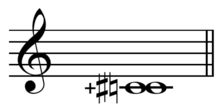Major limma
Major limma (in music) is an interval with the ratio of 135:128, which is the difference between two major tones (a ditone) and a minor third. It is equal to about 92.18 cents.

Major limma on C 
Composer Ben Johnston uses a "−" with a "♭" as an accidental to indicate a note is lowered 92 cents, or a "+" with a "♯" to indicate a note is raised 92 cents, the value of the syntonic comma and the just chromatic semitone.[1]
Sources
- John Fonville. "Ben Johnston's Extended Just Intonation- A Guide for Interpreters", p.109, Perspectives of New Music, Vol. 29, No. 2 (Summer, 1991), pp. 106-137.
gollark: This is a flawless method of comparing information density, yes, before you ask.
gollark: Emojis are encoded in 3-4ish bytes. I analyzed average word length in my notes and found that it was about 5.
gollark: No, they're about 0.8 words.
gollark: Phone keyboards do not offer sufficient information throughput for my mobile typing needs.
gollark: Not that anything by lyricly can be trusted.
This article is issued from Wikipedia. The text is licensed under Creative Commons - Attribution - Sharealike. Additional terms may apply for the media files.